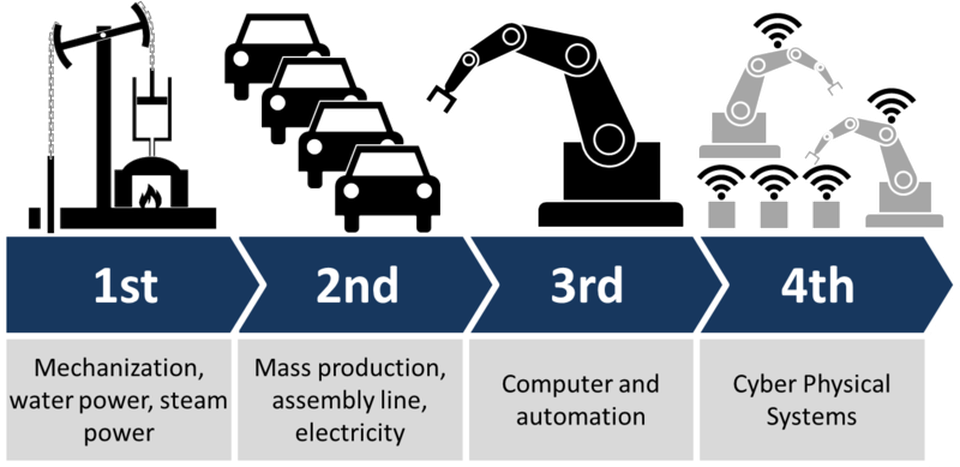The Fourth Industrial Revolution (4IR) – Change is coming…

John Pepper, Marketing Director at OceanWise, gives us Part 1 of his take on the Fourth Industrial Revolution and subsequent changes ahead for the geospatial industry. Part 2 of the article to come in our next Newsletter, Spring 19. The World Economic Forum stated in 2016 that “the world was standing on the brink of a technological revolution that will fundamentally alter the way we live, work, and relate to one another. In its scale, scope, and complexity, this transformation will be unlike anything humankind has experienced before”. (Ref. World Economic Forum White Paper Digital Transformation of Industries: Digital Enterprise).
Image source “The Four Industrial Revolutions, by Christoph Roser at AllAboutLean.com“
Since the Nineteenth Century we have developed steam and water power; electricity and assembly lines then came mass computerisation. The Fourth Industrial Revolution (4IR) combines cyber-physical systems, the Internet of Things (IoT) and the Internet of Systems (IoS).
All of us are responsible for guiding the evolution of 4IR in the decisions we make on a daily basis as citizens, consumers, and investors . We need to grasp the opportunity and power we have to shape 4IR and direct it towards a future that reflects our common objectives and values. The idea of smart factories, smart cities and smart ports etc. in which machines are augmented with web connectivity and connected to a system that can visualize the entire production chain and make decisions on its own, is now becoming a reality.
So how is the geospatial industry responding?
We are responsible for providing the building blocks that enables ‘smart’ decision making and delivers greater efficiencies in government and commerce. We are increasingly challenging the way geospatial data is collected and stored, shared and exchanged in the innovative applications being developed. As ‘everything happens somewhere’, treating data as ‘infrastructure’ is vitally important and in doing so, appreciating data as an asset, which forms part of society’s operational structure – like our road system or power supply.
What changes are we seeing?
In the UK, the Open Data Institute (ODI) is championing free and open access to publicly funded and industry data, whilst the Cabinet Office sponsored ‘Geospatial Commission’ is encouraging and facilitating greater access to, and re-use of, government data. The Department for Transport (DfT) has published its draft Maritime 2050 Strategy which frames the future for ports and harbours. DfT predicts a technological evolution towards our maritime sector becoming more automated, more efficient, effective and productive.

Above Dr Mike Osborne discussing government data with two members of the Cabinet offices’ Geospatial Commission
Data capture technology is developing apace with EO and crowd-sourced data is being routinely used to fill ‘data ‘gaps’ in both the land and marine domains. Autonomous platforms (capable of operating without direct human control) are now being deployed on a regular basis in both coastal and deep ocean space.
It is fair to assume that improved access to high quality (authoritative) data should enable regional and national infrastructure projects to be delivered in a more timely and cost effective manner. However, the biggest challenge in bringing about ‘change’ does not rest with the data, the technology or the standards we use to share and exchange data; it lies with the governance of data vested in organisations and people. As with our other parts of our infrastructure like transport, education and utilities, there are governing bodies, rules, controls, guidelines etc. which we can follow.
We need to embrace a comprehensive and globally shared view of how technology is affecting our lives and reshaping our economic, social, cultural, and human environments rather than continuing to operate with a ‘silo’ mentality.
I would argue that a fresh look is needed at the attributes organisations and people possess and more important need if we are to fully meet the 4IR challenge. The way we have evolved since Victorian times has served us well, but is no longer fit-for-purpose.
How do we embrace this change? Please see our Spring newsletter for the next instalment on this two-part thought piece.






